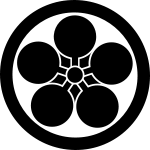Tenri University

Tenri University (天理大学 Tenri Daigaku) is a Japanese private university in Tenri, Nara Prefecture, an independent part of the secular mission of the new religious movement Tenrikyo. It was established in February 1925 as the coeducational Tenri Foreign Language School (天理外国語専門学校 Tenri Gaikokugo Senmon Gakkō), enrolling 104 students, and was reorganised as a university in April 1949.[1]
History
| Tenrikyō |
 |
| Beliefs and scripture |
| Tenri-Ō-no-Mikoto |
| Ofudesaki |
| Osashizu |
| Practices |
| Joyous Life |
| Hinokishin |
| People |
| Nakayama Miki |
| Izo Iburi |
| Places |
| Tenri, Nara |
| Tenri University |
| Tenri Hospital |
| Oyasato-yakata |
As Tenrikyo expanded in the early 20th century, its leaders decided that all adherents had the right to a formal secular education, and the Tenri Foreign Language School was founded at the same time as a public preschool, kindergarten, and elementary school.[2] By the 1970s, it had developed a strong reputation in Japan for foreign language study and judo.[2]
Only one third of Tenri University students are actually Tenrikyo adherents. Its foreign exchange students also come from a variety of religious backgrounds.
Structure and associated institutions
Tenri University is part of the oyasato-yakata complex, a square almost one kilometer in diameter that also houses a seminary, public schools, Tenrikyo lectures, and the Tenri Hospital.
Tenri University operates Tenri Central Library, a notable Japanese library, as well as the Tenri University Sankōkan Museum.
Controversy
In 2002, the school attracted national notice when it was discovered that a professor there had posted student attendance information and grades on his publicly accessible personal website; the university disciplined the professor for violating the students' privacy.[3]
Notable students and faculty
- Anton Geesink, Dutch 10th-dan jūdōka and Olympic gold medalist, studied at Tenri University in 1961[4]
- Shunpei Mizuno, author, graduated in 1990 with a major in Korean language[5]
- Shinichi Shinohara, world-champion gold medalist and Olympic silver medalist jūdōka[6]
- Tadahiro Nomura, World champion and triple Olympic gold medalist in judo
- Shohei Ono, double World champion and Olympic gold medalist in judo
References
- ↑ 沿革 (in Japanese). Tenri University. 2005. Archived from the original on 2007-08-18. Retrieved 2007-07-03.
- 1 2 Hawkins, John N.; Judith A. Takata (July 1972). "Tenri University: A Religious Approach to International Education". Peabody Journal of Education. 49 (4): 300–306. doi:10.1080/01619567209537870. JSTOR 1492467.
- ↑ Brender, Alan (2002-03-20). "Japanese University Reprimands Professor for Posting Names and Grades on a Public Web Site". The Chronicle of Higher Education. Archived from the original on 2007-09-30. Retrieved 2007-07-03.
- ↑ Geesink, Anton (1966). My Championship Judo. Arco. ISBN 0-668-01501-2.
- ↑ "光州の人気者 方言巧み「面白い日本人」(Popular people in Gwangju: The "amusing Japanese" who's good at the local dialect)". Hokkaidō Shimbun. 2002-03-27. Archived from the original on 2007-07-01. Retrieved 2007-07-03.
- ↑ "Japan's judo giant seeks revenge over French rival". CNN. 2000-08-25. Retrieved 2007-07-03.
External links
Coordinates: 34°35′51″N 135°50′43″E / 34.59750°N 135.84528°E